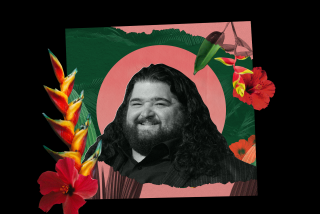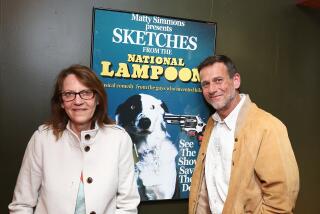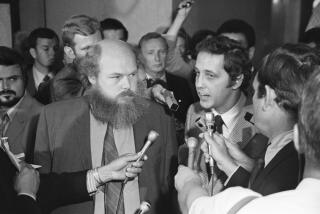Jean Peters; Actress in Film, TV Married Howard Hughes
- Share via
Jean Peters, a popular actress in the 1950s who vanished into the mysterious life of billionaire Howard Hughes after their 1957 marriage, died of leukemia Oct. 13 in La Jolla. She was 73.
Peters, who was diagnosed with leukemia in August, was buried Tuesday at Holy Cross Cemetery in Culver City.
For the record:
12:00 a.m. Oct. 22, 2000 For the Record
Los Angeles Times Sunday October 22, 2000 Home Edition Calendar Page 2 Entertainment Desk 1 inches; 24 words Type of Material: Correction
Actress Katy Jurado played Spencer Tracy’s Indian wife in “Broken Lance.” The name of the film was incorrectly identified in an article in the movie section on Sunday Oct. 21.
Although she had appeared in 19 movies with such leading men as Marlon Brando, Ray Milland and Spencer Tracy, Peters was never able to shake the identity she gained when she wed the eccentric Hughes.
She stopped making movies and gave up public life, spending the 13 years of her marriage to Hughes living in his well-guarded mansion near Beverly Hills or visiting him in Las Vegas, where he led a hermitic existence in a penthouse fortress in his later years.
When Peters resurfaced to act in a television play in 1972, after divorcing the famous recluse, she still refused to talk about her former life as Mrs. Howard Hughes.
“I’m not so naive as to think your only reason to be here is your interest in my career,” she told reporters at a packed news conference. “But my life with Howard Hughes was and shall remain a matter on which I will have no comment.”
Peters came to Hollywood from Canton, Ohio, when she was 19. She had won the Miss Ohio pageant in 1945, which entitled her to a screen test at 20th Century Fox. The story goes that studio boss Darryl F. Zanuck took one look at the buxom green-eyed brunet and said, “Sign her!” He cast her in a starring role opposite Tyrone Power in the 1947 film “Captain From Castile,” an epic tale of the Spanish conquest of Mexico.
Over the next decade, “I was usually an Indian or a lady pirate,” she told The Times, because Zanuck was impressed with her athletic ability.
Other prominent roles followed with some of Hollywood’s biggest stars, including “Viva Zapata!” in 1952 with Brando and Anthony Quinn, “Pickup on South Street” with Richard Widmark in 1953, “Apache” with Burt Lancaster in 1954 and “Broken Lance” with Tracy in 1954.
Her last movie role was as the tubercular wife of a clergyman who becomes U.S. Senate chaplain in “A Man Called Peter” in 1955.
She was briefly married to Texas oilman Stuart Cramer III, whom she met while filming the 1954 movie “Three Coins in a Fountain” in Rome. But a friend, actress Jeanne Crain, told The Times in 1976 that Peters had married Cramer because she thought a relationship with Hughes would not work out. But Peters, Crain said, “just couldn’t forget” Hughes.
She reportedly first met Hughes when she arrived in Hollywood. According to “Howard Hughes: The Untold Story” by Peter Harry Brown and Pat H. Broeske, both Hughes and Peters were guests at a Fourth of July boating party to Catalina in 1946 that began at the home of producer Bill Cagney, brother of actor James Cagney.
Peters’ date was Audie Murphy, the World War II hero, but that did not deter Hughes, a notorious ladies’ man. He talked several of the guests into flying to Catalina in his private plane, putting Peters in the cockpit next to him.
It was not until 11 years later--on May 13, 1957--that they were wed, in a secret ceremony in Tonopah, Nev. Peters was 30 and Hughes was 51.
For the next 13 years, she was rarely spotted in public, fueling speculation that she was gravely ill or had become a prisoner of Hughes. She refused interviews in accordance with Hughes’ obsession with privacy. A writer for Ladies Home Journal who attempted to interview her in 1970 claimed that agents of the billionaire had tried to discourage him with offers of expensive cars and cash.
Columnist Jack Anderson once described the marriage to his readers, telling of Hughes’ long disappearances and of awkward meetings when the billionaire, who feared germs, would insist that his wife stay on the opposite side of the room.
Much later, Peters revealed how she had spent some of her time. She was not the recluse that her husband was. She took classes at UCLA in psychology, anthropology and painting, enrolled under her own name, Elizabeth Jean Peters. She recorded audio books for the blind “until I couldn’t stand the sound of my own voice anymore.”
Still, she was rarely recognized. One time, when she was doing door-to-door political polling, an actor recognized her from a late-night movie. “That’s when I would get recognized, when one of those awful movies was on TV,” she said.
She and Hughes were divorced in 1971. That same year she married writer-producer Stanley Hough, whom Peters had first met when he was an assistant director on her early movies. When Hough died in 1990, Peters moved from Beverly Hills to Carlsbad, Calif., to be near her sister, Shirley Cook, who survives her.
It was Hough who encouraged Peters to take up acting again. At 46, she played the role of a middle-aged mother in the 1972 Hollywood Television Theatre production of a play based on the Sherwood Anderson novel “Winesburg, Ohio.”
More television roles followed, including an appearance in a 1984 episode of “Murder, She Wrote,” the Angela Lansbury mystery series.
She enjoyed the revival of her professional life. But she knew that she would always be known as the ex-Mrs. Hughes. Asked once if she thought she would ever shake that identity, she said, “I’d like to hope so, but I’m a realist.”
Hughes was not seen in public for the last 20 years of his life. When Peters learned that he had died on an emergency medical flight from Acapulco to Houston in 1976, she said, “I’m sorry. I’m saddened.”
More to Read
Only good movies
Get the Indie Focus newsletter, Mark Olsen's weekly guide to the world of cinema.
You may occasionally receive promotional content from the Los Angeles Times.










